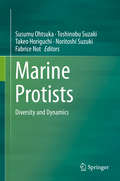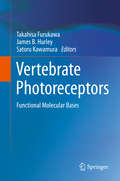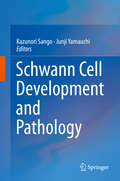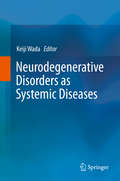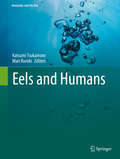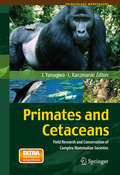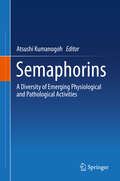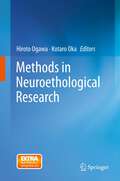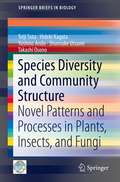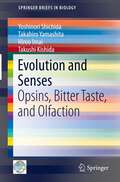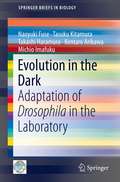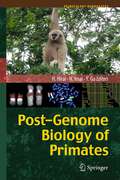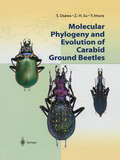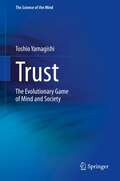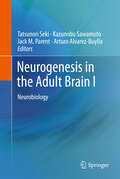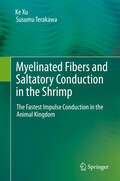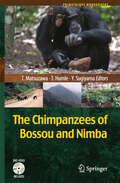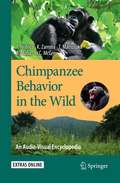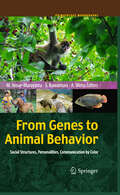- Table View
- List View
Marine Protists: Diversity and Dynamics
by Susumu Ohtsuka Toshinobu Suzaki Takeo Horiguchi Noritoshi Suzuki Fabrice NotThis comprehensive book provides a unique overview of advances in the biology and ecology of marine protists. Nowadays marine protistology is a hot spot in science to disclose life phenomena using the latest techniques. Although many protistological textbooks deal with the cytology, genetics, ecology, and pathology of specific organisms, none keeps up with the quick pace of new discoveries on the diversity and dynamics of marine protists in general. The bookMarine Protists: Diversity and Dynamics gives an overview of current research on the phylogeny, cytology, genomics, biology, ecology, fisheries, applied sciences, geology and pathology of marine free-living and symbiotic protists. Poorly known but ecologically important protists such as labyrinthulids and apostome ciliates are also presented in detail. Special attention is paid to complex interactions between marine protists and other organisms including human beings. An understanding of the ecological roles of marine protists is essential for conservation of nature and human welfare. This book will be of great interest not only to scientists and students but also to a larger audience, to give a better understanding of protists’ diverse roles in marine ecosystems.
Vertebrate Photoreceptors: Functional Molecular Bases
by Takahisa Furukawa James B. Hurley Satoru KawamuraThis book provides a series of comprehensive views on various important aspects of vertebrate photoreceptors. The vertebrate retina is a tissue that provides unique experimental advantages to neuroscientists. Photoreceptor neurons are abundant in this tissue and they are readily identifiable and easily isolated. These features make them an outstanding model for studying neuronal mechanisms of signal transduction, adaptation, synaptic transmission, development, differentiation, diseases and regeneration. Thanks to recent advances in genetic analysis, it also is possible to link biochemical and physiological investigations to understand the molecular mechanisms of vertebrate photoreceptors within a functioning retina in a living animal.Photoreceptors are the most deeply studied sensory receptor cells, but readers will find that many important questions remain. We still do not know how photoreceptors, visual pigments and their signaling pathways evolved, how they were generated and how they are maintained. This book will make clear what is known and what is not known. The chapters are selected from fields of studies that have contributed to a broad understanding of the birth, development, structure, function and death of photoreceptor neurons. The underlying common word in all of the chapters that is used to describe these mechanisms is “molecule”. Only with this word can we understand how these highly specific neurons function and survive. It is challenging for even the foremost researchers to cover all aspects of the subject. Understanding photoreceptors from several different points of view that share a molecular perspective will provide readers with a useful interdisciplinary perspective.
Schwann Cell Development and Pathology
by Kazunori Sango Junji YamauchiThis book presents recent topics on the development, differentiation, and myelination of Schwann cells, as well as pathological mechanisms and therapeutic approaches for peripheral neuropathies, such as Charcot–Marie–Tooth diseases, amyloid polyneuropathy, immune-mediated neuropathy and diabetic neuropathy. The rapid progress of molecular biological techniques in the last decades, especially for RNA techniques and gene modification technologies have allowed us to investigate the pathobiology of Schwann cells in vivo and in vitro. Studies combining recent stem cell biology with recent biotechnology, which is now closely linked to physicochemical fields, further explain how Schwann cell lineages develop a process that has long been thought to be very complicated in vivo. The findings contribute to the elucidation of fundamental mechanisms during development and under pathological conditions. We now know that these are closely tied to each other. This book also introduces unique coculture systems to reproduce the neuron–Schwann cell interplay during development, degeneration, and regeneration. Up-to-date research topics with high-quality immunofluorescence and electron micrographs introduced by young and energetic contributors are sure to arouse the readers' interest in Schwann cell biology. Discussion from the viewpoint of basic and clinical neuroscience makes the book educational for researchers, medical students and young clinicians.
Neurodegenerative Disorders as Systemic Diseases
by Keiji WadaThis book sheds new light on neurodegenerative disorders as systemic diseases. Classically, neuronal cell death was a hallmark of such disorders. However, it has become evident that neural dysfunction is more important in the pathophysiology of neurodegenerative disorders. More recently, the prionoid-spreading hypothesis of disease-causing molecules has attracted a great deal of attention. Therapeutic strategies thus must be reconsidered in the light that neurodegenerative disorders are indeed systemic diseases. The first part of this book introduces the concept of neurodegeneration in biology and pathophysiology. The second part focuses on clinical evaluation and biomarkers from the perspective of this new concept, while the third summarizes the risk factors of neurodegeneration. The fourth part of this work indicates future directions of treatment, and the final part discusses health promotion for prevention and quality of life. This book will be of interest to both researchers and medical personnel, and provides a fresh approach to neurodegenerative diseases, paving the way to new research and improved quality of health care for patients.
Eels and Humans (Humanity and the Sea)
by Katsumi Tsukamoto Mari KurokiThis book explains much of what is known currently about freshwater eels, focusing on social and cultural aspects as well as science. A wealth of eel-related material is presented by scientists from around the world, including information on eel fishing, resources, distribution, aquaculture, economics, cuisine, environment and ecosystems, idioms, arts and crafts, tradition, legends, mythology, archaeology and even memorial services.Eels are important as food for humankind and are an interesting model for scientists studying animal migration and reproductive ecology. Their snake-like morphology differentiates them from most other fish, and their unpredictable behaviour that allows them to move over wet land and climb rocks adjacent to waterfalls attracts attention and evokes curiosity. Eels are therefore considered to be enigmatic creatures or metaphysical entities beyond human intelligence; indeed, they have been deified in parts of the world.In recent decades, however, with global populations of eels in sharp decline, some species face a real threat of extinction, and effective conservation strategies and measures are needed. Comparisons across these issues between various countries provide an image of a long-lasting relationship between eels and humankind, and encourage comprehensive and detailed understanding of eels from the perspectives of social, cultural and natural sciences. By promoting understanding of the close relationship between eels and humans, the broader public is engaged and public awareness of eel importance raised, helping to conserve these unique but endangered fish.
Primates and Cetaceans: Field Research and Conservation of Complex Mammalian Societies (Primatology Monographs)
by Juichi Yamagiwa Leszek KarczmarskiIn this book, the editors present a view of the socioecology of primates and cetaceans in a comparative perspective to elucidate the social evolution of highly intellectual mammals in terrestrial and aquatic environments. Despite obvious differences in morphology and eco-physiology, there are many cases of comparable, sometimes strikingly similar patterns of sociobehavioral complexity. A number of long-term field studies have accumulated a substantial amount of data on the life history of various taxa, foraging ecology, social and sexual relationships, demography, and various patterns of behavior: from dynamic fission–fusion to long-term stable societies; from male-bonded to bisexually bonded to matrilineal groups.Primatologists and cetologists have come together to provide four evolutionary themes: (1) social complexity and behavioral plasticity, (2) life history strategies and social evolution, (3) the interface between behavior, demography, and conservation, and (4) selected topics in comparative behavior. These comparisons of taxa that are evolutionarily distant but live in comparable complex sociocognitive environments boost our appreciation of their sophisticated mammalian societies and can advance our understanding of the ecological factors that have shaped their social evolution. This knowledge also facilitates a better understanding of the day-to-day challenges these animals face in the human-dominated world and may improve the capacity and effectiveness of our conservation efforts.
Semaphorins: A Diversity of Emerging Physiological and Pathological Activities
by Atsushi KumanogohThis book presents the current concepts of semaphorin biology. In the early 1990s, semaphorins were originally identified as axon guidance cues that function during neuronal development. However, cumulative findings have clarified that they have diverse functions in many physiological processes, including cardiogenesis, angiogenesis, vasculogenesis, osteoclastogenesis, retinal homeostasis, and immune regulation. Additionally, they have been implicated in the pathogenesis of various human diseases, including tumorigenesis/tumor metastasis, neuroregenerative diseases, retinal degeneration, irregular pulse/sudden death, and immune disorders. Based on this current research background, the book covers the essential state-of-the-art findings for basic scientists in biochemistry, molecular biology, neuroscience, developmental biology, and structural biology, as well as for physicians in neurology, cardiology, oncology, orthopedic surgery, otorhinolaryngology, ophthalmology, allergology, and rheumatology.
The Olfactory System: From Odor Molecules to Motivational Behaviors
by Kensaku MoriThis book summarizes recent advances in understanding of the mammalian and fish olfactory system and provides perspective on the translation of external odor information into appropriate motivational and behavioral responses. Following the discovery of the odorant receptor gene family in 1991, understanding of the basic biological mechanisms of the olfactory system has advanced enormously. Despite such rapid progress, however, it remains unclear how odor information is processed at levels beyond the olfactory bulb, including the olfactory cortex, olfactory tubercle, and orbitofrontal cortex. This book thus describes the most recent developments in olfactory research, with particular focus on the basic neurobiological mechanisms of the neuronal circuit function in the olfactory system and its related higher centers. Exploring the basic functional logic of the neuronal circuits in the olfactory system in this way appears to be crucial in understanding the workings of the complex neuronal circuits of the brain, particularly those in the cerebral cortex that link sensory perception to appropriate behavioral responses. This book is written for the coming generation of scientists: undergraduates, graduate students, and postdoctoral researchers in the fields of neuroscience, neurobiology, chemical senses, food and nutritional sciences, medical science, sensory psychology, and behavioral sciences.
Methods in Neuroethological Research
by Hiroto Ogawa and Kotaro OkaThe rapid progress of neuroscience in the last decade can be largely attributed to significant advances in neuroethology, a branch of science that seeks to understand the neural basis of natural animal behavior. Novel approaches including molecular biological techniques, optical recording methods, functional anatomy, and informatics have brought drastic changes in how the neural systems underlying high-level behaviors such as learning and memory are described. This book introduces recent research techniques in neuroethology, with diverse topics involving nematodes, insects, and vertebrates (birds, mice and primates), divided into sections by research method. Each section consists of two chapters written by different authors who have developed their own unique approaches. Reports of research in “model animals” including C. elegans, Drosophila, and mice, which were not typical specimens in conventional neuroethology, have been deliberately selected for this book because a molecular genetic approach to these animals is necessary for advances in neuroethology. Novel methodology including optical recording and functional labeling with reporter genes such as GFP has been actively used in recent neurobiological studies, and genetic manipulation techniques such as optogenetics also are powerful tools for understanding the molecular basis of neural systems for animal behavior. This book provides not only these new strategies but also thought-provoking statements of philosophy in neuroethology for students and young researchers in the biological sciences.
Species Diversity and Community Structure: Novel Patterns and Processes in Plants, Insects, and Fungi (SpringerBriefs in Biology)
by Teiji Sota Hideki Kagata Yoshino Ando Shunsuke Utsumi Takashi OsonoThis book introduces recent progress in the study of species diversity and community structures in terrestrial organisms conducted by three groups at Kyoto University. First, it explains species diversity and the functioning of fungi in Asian regions as outlined by metagenomic approaches using next-generation sequencing technology. The advances in high-throughput sequencing technologies accelerate the speed of species inventorying, especially for microorganisms. Second, the study of complex interactions between herbivorous insects and plants in the community and ecosystem contexts is presented. Recent studies in community and ecosystem genetics shed light on these complex interactions with novel approaches incorporating genetic perspectives including genetic variation and phenotypic plasticity in plant defenses against herbivores. Finally, recent studies on speciation processes in insects are described, processes that are related to the evolution of particular life history strategies. Included is an examination of two hypotheses that may be important in understanding diversification of insect species in heterogeneous environments in space and time. This book is a valuable resource especially for ecologists who are interested in species diversity and community structure.
Evolution and Senses: Opsins, Bitter Taste, and Olfaction (SpringerBriefs in Biology)
by Yoshinori Shichida Takahiro Yamashita Hiroo Imai Takushi KishidaThis book focuses on sensing and the evolution of animals. Using the five senses (visual, auditory, and olfactory perception, and taste and touch), animals can receive environmental stimuli and respond to them. Changes in these sensitivities might cause changes in aspects of animals’ lives such as habitat, activity timing, and diet—and vice versa. Recent advances in genome and molecular analysis enable us to investigate certain changes in the receptors or mechanisms involved in sensing and provide clues for understanding the evolution of animals related to those changes. The first chapter deals with the molecular evolution of opsins. In addition to the well-known function of opsins as visual receptors, opsins can be related to non-visual photoreception such as photoentrainment of circadian rhythm, photoperiodism, and background adaptation. Molecular phylogenic studies reveal that all opsin genes have evolved from one ancient opsin gene. The evaluation of the functions of each extant opsin protein based on the molecular features enables us to predict the molecular evolution and diversification of opsins during the evolution of animals. These studies shed light on which amino-acid substitutions cause the functional diversification of opsins and how they have influenced the evolution of animals. The second chapter has to do with bitter taste perception, a key detection mechanism against the ingestion of bioactive substances. Genetic and behavioral evidence reveal the existence of "non-taster" Japanese macaques for specific bitter compounds, which originated in a restricted region of Japan. This finding might provide a clue for elucidating the ecological, evolutionary, and neurobiological aspects of bitter taste perception of primates. The third chapter presents an extreme example of the evolution of olfaction, namely, that fully aquatic amniotes have generally reduced their olfactory capacity considerably compared to their terrestrial relatives. Interestingly, the remaining olfactory abilities are quite different among three fully aquatic amniotes investigated: toothed whales have no nervous system structures that mediate olfaction, but baleen whales can smell in air, and it has been suggested that sea snakes smell underwater.
Monkeys, Apes, and Humans: Primatology in Japan (SpringerBriefs in Biology)
by Michael A. Huffman Naofumi Nakagawa Yasuhiro Go Hiroo Imai Masaki TomonagaThis book introduces to the reader unfamiliar with primatology in Japan three research projects representative of the unique multidisciplinary approach carried out by scientists at Kyoto University, the country’s premier institution for primate studies. The projects are all aimed at understanding the age-old questions, where did we come from, and what makes us unique or similar to our primate ancestors? The first chapter, by Naofumi Nakagawa, focuses on the cultural diversity of social behavior in the Japanese macaque. This chapter reviews research on primate culture, in particular the work on Japanese macaques, then presents what is arguably the first example of a culturally transmitted social convention in the species, called “hug-hug”. The second chapter, by Michael A. Huffman, introduces our current knowledge of self-medication in primates, based largely on a long-term study of wild chimpanzees at Kyoto University’s longest ongoing chimpanzee field in Africa, Mahale, in Tanzania. The suite of behavioral adaptations to parasite infections in chimpanzees is compared with our current knowledge of self-medication in other primates and other animal species. The third chapter, by Yasuhiro Go, Hiroo Imai, and Masaki Tomonaga, describes the ambitious efforts to combine cognitive science and genomics into a new discipline called “comparative cognitive genomics”. This chapter provides an overview of recent advancements in chimpanzee comparative cognition, the construction of a chimpanzee genomic database, and comparative genomic studies at the individual level, looking into factors affecting personality and individuality.
Evolution in the Dark: Adaptation of Drosophila in the Laboratory (SpringerBriefs in Biology #1)
by Naoyuki Fuse Tasuku Kitamura Takashi Haramura Kentaro Arikawa Michio ImafukuHow organisms come to possess adaptive traits is a fundamental question for evolutionary biology. Although it is almost impossible to demonstrate evolution in the laboratory, this issue can be approached by using an unusual organism, “Dark-fly”: Drosophila melanogaster kept in complete darkness for 57 years through 1,400 generations, which corresponds to 28,000 years in terms of human generations. Has Dark-fly adapted to an environment of total darkness? If so, what is the molecular nature of the adaptation? In Evolution in the Dark, the remarkable findings from the Dark-fly project performed at Kyoto University are presented. It was found that Dark-fly did not have poor eyesight, but rather exhibited higher phototaxis ability and displayed lengthened bristles on the head that function as tactile receptors. Circadian rhythms were weakened but still retained in Dark-fly. With recent progress in genome science enabling researchers to perform whole genome sequencing for Dark-fly, a large number of mutations were identified including genes encoding a light receptor, olfactory receptors, and enzymes involved in neural development. The Dark-fly project is a simple but very long-term experiment. Combined with advanced techniques in genetics and genomics, it is a valuable tool for understanding the molecular nature of adaptive evolution.
Emotions of Animals and Humans: Comparative Perspectives (The Science of the Mind)
by Shigeru Watanabe and Stan KuczajThis book takes a multidisciplinary approach to emotion, with contributions from biologists, psychologists, neuroscientists, robot engineers, and artists. A wide range of emotional phenomena is discussed, including the notion that humans’ sophisticated sensibility, as evidenced by our aesthetic appreciation of the arts, is based at least in part on a basic emotional sensibility that is found in young children and perhaps even some non-human animal species. As a result, this book comprises a unique comparative perspective on the study of emotion. A number of chapters consider emotions in a variety of animal groups, including fish, birds, and mammals. Other chapters expand the scope of the book to humans and robots. Specific topics covered in these chapters run the gamut from lower-level emotional activity, such as emotional expression, to higher-level emotional activity, such as altruism, love, and aesthetics. Taken as a whole, the book presents manifold perspectives on emotion and provides a solid foundation for future multidisciplinary research on the nature of emotions.
Japanese Commons in the Coastal Seas: How the Satoumi Concept Harmonizes Human Activity in Coastal Seas with High Productivity and Diversity
by Tetsuo YanagiThe author proposed the satoumi concept, analogous to the satoyama concept on land, as “coastal sea with high biodiversity and productivity in harmony with human interaction” in 1998. The concept for environmental conservation in the coastal seas has been widely accepted and was included in the Japanese national policy of “Strategy for Establishment of an Environmental Nation” in 2007. This book is a translation of the author’s Japanese book (2010) in response to concerns and questions about satoumi, including: Does biodiversity increase as a result of human interaction in coastal seas? Do the economics of fishing villages need to be considered in detail? What legal support is necessary for the creation of satoumi? Is there a relation between the concepts of God and Nature in satoumi? What is the relationship between fishermen and city dwellers? Chapter 1 presents the basic concept of satoumi. In Chapter 2 the relation between biodiversity and human interaction, economic problems related to satoumi, legal support for satoumi creation, satoumi from the point of view of landscape ecology, and the relation between society and science with regard to the satoumi movement are discussed. In Chapter 3 examples of satoumi creation in Japan are presented, and in Chapter 4 the overseas dissemination of the satoumi concept is introduced, with Chapter 5 providing the conclusion. Chapter 1 presents the basic concept of satoumi. In Chapter 2 the relation between biodiversity and human interaction, economic problems related to satoumi, legal support for satoumi creation, satoumi from the point of view of landscape ecology, and the relation between society and science with regard to the satoumi movement are discussed. In Chapter 3 examples of satoumi creation in Japan are presented, and in Chapter 4 the overseas dissemination of the satoumi concept is introduced, with Chapter 5 providing the conclusion.
Post-Genome Biology of Primates (Primatology Monographs)
by Hirohisa Hirai, Hiroo Imai and Yasuhiro GoIn 2001, first reports of the human draft genome were published. Since then, genomes of many other organisms have been sequenced, including several primate species: the chimpanzee, rhesus macaque, gorilla, orangutan, gibbon, baboon, marmoset, tarsier, galago, lemur, and more recently Neanderthals. In a new era of "post-genome biology", scientists now have the vast amount of information revealed by genome research to confront one of the most challenging, fundamental questions in primatology and anthropology: What makes us human? This volume comprises a collection of articles on a variety of topics relevant to primate genomes, including evolution, human origins, genome structure, chromosome genomics, and bioinformatics. The book covers the cutting-edge research in molecular primatology and provides great insights into the functional diversity of primates. This valuable collection will benefit researchers and students, including primatologists, anthropologists, molecular biologists, evolutionary biologists, and animal behaviorists.
Protection of the Three Poles
by Falk HuettmannThe Arctic, the Antarctic, and the Hindu Kush-Himalayas form a trio of terrains sometimes called “the three poles”. Mainly composed of rock, snow, and ice, these precious regions, which are home to many unique species such as the polar bear, the emperor penguin, and the snow leopard, contain the primary water resource of this planet and directly shape our climate. This book presents a first-ever global assessment and progressive review of the three poles and demonstrates the urgent need for their protection. Sins of the past have irrevocably harmed and threatened many of the unique qualities of these regions, and the future looks bleak with the global population forecast to reach 9 billion by 2060, and with climate change on the rise. Presented here is a wide-reaching and coherent overview of the three poles’ biodiversity, habitats, and ongoing destruction. Failed protection and social targets set by the United Nations and other bodies are exposed while economic growth, unconstrained or inappropriate development, and urban sprawl are promoted unabated. Polar regions play a major role in the global agenda as they are rich in oil and other resources, marking them for contamination, overfishing, and further degradation. Tourism in the Antarctic has benefited from enlightened self-regulation, but there are signs that this is changing, too. The chapters of this book are written by experts in their fields, and their evidence leaves no doubt that we already live beyond our carrying capacity on a finite but decaying space. A global protection role model and several outlook scenarios are proposed to help set in motion polar protection priorities that are actually valid. Humanity has demonstrated through international treaties such as the Antarctic Treaty and the Madrid Protocol that we can put the interests of the planet as a whole first. This must become the norm, not the exception.
Patch Clamp Techniques: From Beginning to Advanced Protocols (Springer Protocols Handbooks)
by Yasunobu OkadaChannels and transporters are multi-functional proteins that mediate substrate transport and signal transmission and simultaneously act as regulators for other proteins and biosensors for environmental materials. Patch clamping is an epoch-making technique that allows researchers to perform real-time measurements of electrogenic channel/transporter functions at the single/multiple molecular level. This book describes not only the conventional patch clamp techniques but also their newly developed variations or applications, such as perforated patch, slice patch, blind patch, in vivo patch, imaging patch, smart patch, and automated patch clamping. These patch clamp techniques are now essential and are extensively used across the life sciences and in related industries. With plain and practical descriptions of patch clamping and how to carry it out, especially for beginners, the book also shows how widely and exquisitely the patch clamp techniques can be applied by expert electrophysiologists. This work serves as a useful guide for young researchers and students in training and laboratory courses as well as for senior researchers who wish to extend their repertoire of techniques.
Molecular Phylogeny and Evolution of Carabid Ground Beetles
by S. Osawa Z.-H. Su Y. ImuraCarabid ground beetles, sometimes called "walking jewels", are among the most thoroughly investigated insects in the world. This book presents the results of molecular phylogenetic analyses of 2000 specimens, including 350 species and that cover more than 90% of the known genera, from 500 localities in 35 countries. These comprehensive analyses using mitochondrial DNA-based dating suggest that carabid diversification took place about 40 to 50 million years ago as an explosive radiation of the major genera, coinciding with the collision of the Indian subcontinent and Eurasian land mass. The analyses also lead to surprising conclusions suggesting discontinuous evolution and parallel morphological evolution. With numerous color illustrations, this book presents readers with the dynamic principles of evolution and the magnificent geographic history of the earth as revealed by the study of beetles.
Trust: The Evolutionary Game of Mind and Society (The Science of the Mind)
by Toshio YamagishiThis book is written around the central message that collectivist societies produce security, but destroy trust. In collectivist societies, people are connected through networks of strong personal ties where the behavior of all agents is constantly monitored and controlled. As a result, individuals in collectivist networks are assured that others will abide by social norms, and gain a sense of security erroneously thought of as “trust.” However, this book argues that this security is not truly trust, based on beliefs regarding the integrity of others, but assurance, based on the system of mutual control within the network. In collectivist societies, security is assured insofar as people stay within the network, but people do not trust in the benevolence of human nature. On the one hand, transaction costs are reduced within collectivist networks, as once accepted into a network the risk of being maltreated is minimized. However, joining the network requires individuals to pay opportunity cost, that is, they pay a cost by forgoing potentially superior opportunities outside the security of the network. In this era of globalization, people from traditionally collectivistic societies face the challenge of learning how to free themselves from the security of such collectivistic networks in order to explore the opportunities open to them elsewhere. This book presents research investigating how the minds of individuals are shaped by the conflict between maintaining security inside closed networks of strong ties, and venturing outside of the network to seek out new opportunities.
Neurogenesis in the Adult Brain I: Neurobiology
by Tatsunori Seki, Kazunobu Sawamoto, Jack M. Parent and Arturo Alvarez-BuyllaThe discovery of adult neurogenesis caused a paradigm shift in the neurosciences. For more than 100 years, it was believed that adult neurons do not regenerate. Joseph Altman and Fernando Nottebohm found proof to the contrary and changed the course of history. Their research, included here, provides the foundations of the field. Today, adult neurogenesis is a rapidly expanding discipline applicable to the study of brain development and diseases, learning and memory, aging, and neuropsychiatric disorders. With multiple authors, the 27 chapters of this book contain the latest work in two volumes. The first presents the basic biology of adult neurogenesis in non-mammalian vertebrates and in the mammalian hippocampus and olfactory bulb, and the second discusses clinical implications and delves into adult neurogenesis and brain injury as well as neurodegenerative and neuropsychiatric pathologies. With details of the anatomy, physiology, and molecular biology of the two neurogenic brain regions, this book provides indispensable knowledge for many areas of neuroscience and for experimental and clinical applications of adult neurogenesis to brain therapy.
Myelinated Fibers and Saltatory Conduction in the Shrimp: The Fastest Impulse Conduction in the Animal Kingdom
by Ke Xu Susumu TerakawaIn 1961, neurobiologists found that the conduction velocity of the nerve impulse in the giant nerve fiber of the Penaeus shrimp abdominal nerve cord was over 200 m/s, the highest speed of information transmission ever observed in the animal kingdom. The peculiar myelin sheath with its unique nodal structure and the electrical properties of the nerve fibers of the shrimp have continued to be investigated for a quarter of century and are now fully described in this book. The investigation dispels the commonly held belief that the fastest recorded impulse conduction is about 120 m/s in the thickest vertebrate myelinated nerve fibers. In the shrimp, researchers found a completely novel type of functional node in the giant fiber which they designated as the fenestration node. In portions of the myelinated fiber, the fenestration node furnished the sites of excitation. Also discovered was a new strategy for increasing impulse conduction in the shrimp. The book includes a section on the formation of the fenestration node and the discovery of a strategy that allows the shrimp to escape its predators by an action of the fastest velocity. The data presented in this volume on the myelin sheath of invertebrates present a new direction for this field and a rich source of information for neurobiologists worldwide.
The Chimpanzees of Bossou and Nimba
by Tetsuro Matsuzawa, Tatyana Humle and Yukimaru SugiyamaThe chimpanzees of Bossou in Guinea, West Africa, form a unique community which displays an exceptional array of tool use behaviors and behavioral adaptations to coexistence with humans. This community of Pan troglodytes verus has contributed more than three decades of data to the field of cultural primatology, especially chimpanzees’ flexible use of stones to crack open nuts and of perishable tools during foraging activities. The book highlights the special contribution of the long-term research at Bossou and more recent studies in surrounding areas, particularly in the Nimba Mountains and the forest of Diécké, to our understanding of wild chimpanzees’ tool use, cognitive development, lithic technology and culture. This compilation of research principally strives to uncover the complexity of the mind and behavioral flexibility of our closest living relatives. This work also reveals the necessity for ongoing efforts to conserve chimpanzees in the region. Chimpanzees have shed more light on our evolutionary origins than any other extant species in the world, yet their numbers in the wild are rapidly declining. In that sense, the Bossou chimpanzees and their neighbors clearly embody an invaluable cultural heritage for humanity as a whole.Readers can enjoy video clips illustrating unique behaviors of Bossou chimpanzees, in an exclusive DVD accompanying the hardcover or at a dedicated website described in the softcover.
Chimpanzee Behavior in the Wild: An Audio-Visual Encyclopedia
by Toshisada Nishida Koichiro Zamma Agumi Inaba Takahisa Matsusaka William C. McGrewWhere We Stand Field workers—scientists of animal (including human!) behavior in nature—have long been fascinated by wild chimpanzees. A person who once has studied wild chimpanzees will be eager to observe them again. A person who has studied them twice will make every effort to continue the study, unless prevented from doing so. In short, behavioral primatology is addictive! Many people, among them Jane Goodall, Richard Wrangham, and I, do not regret that they have dedicated their whole lives to the study of wild chimpanzees. This is because the apes’ behavior is always challenging: chimpanzees are cheerful, charming, playful, curious, beautiful, easygoing, generous, tolerant, and trustw- thy most of the time, but also are cautious, cunning, ugly, violent, ferocious, blo- thirsty, greedy, and disloyal at other times. We human beings share both the light and dark sides with our closest living relatives. For decades, we have documented huge across-population variation in behavior, as well as within-population variation. Cultural biology (now called cultural pri- tology), as proposed 60 years ago by Kinji Imanishi, recently has flourished.
From Genes to Animal Behavior: Social Structures, Personalities, Communication by Color (Primatology Monographs)
by Miho Inoue-Murayama, Shoji Kawamura and Alexander WeissThe biological and genetic bases of behavioral diversity have long been topics of study within many disciplines, including evolutionary biology, genetics, ethology, sociobiology, and comparative psychology, but only relatively recently have attempts been made to bring these different approaches together. This volume covers a wide range of interdisciplinary research which uses some of the newest and most promising methods and technologies. Presented here is an overview of findings in the ongoing search for the ultimate causes of behavior in several different species, including primates, dogs, rodents, birds, and fish. Divided into five parts, the work describes research on sexual and kin selection, personality and temperament, molecular genetics of personality, color vision and body coloration, and the neurological underpinnings of complex behaviors. Valuable for researchers as well as graduate students in a wide range of fields from neuroscience to ecology, the book is also useful to those seeking to move beyond the boundaries of their own discipline and to expand their knowledge.
